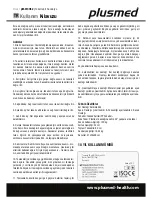
Manual wheelchairs with push rims enable a wheelchair user to
propel themselves in the chair. Chair without push rims are
usually pushed by a person using handles on the back of the
chair.
Steps
1. Preparing the hands: Especially if you are learning, keep your
fingernails trimmed short so they are less likely to tear. You may
want to wear fingerless gloves, such as weightlifting gloves, to
protect your hands from both dirt and injury.
2. Gripping the wheels: A manual chair meant to be under the
control of its occupant will have a metal rim intended for the
hands, called a push rim. This rim does not touch the ground. It
may be easier for you to grip the whole wheel (both the rim and
the tire). Either way is fine.
3. Going forwards: To go forwards, reach backwards and grip the
wheels as far back as you can. Push the wheels forward by
keeping hold of the rims and moving them in a forwards direction.
4. Going backwards: Reach forwards and grip the wheels, and
push them backwards. Be careful, as the little wheels at the front
will need to swivel round. Don’t forget to look behind you!
5. Turning right: Hold the right wheel still, and push the left wheel
forwards.
6. Turning left: Hold the left wheel still, and push the right wheel
forwards.
7. Spinning on the sport: If in a tight corner, you may need to spin
on the spot.
8. Stopping: Grip the rims and use friction to slow them down.
Pinch the push rim between your thumb and the side of the first
joint of your index finger. If the rims are wet, pinch the tire inste-
ad. Use caution, as this friction creates heat that can burn your
hands if you are on a slope or stopping suddenly.
9. Staying still: If you will be staying still for some time-e.g. To sit
at a stable - or you will be using your hands for something - e.g.
to take off your coat - then put the brakes on - or else you might
roll backwards!
10. Going over bumps: Avoid bumps where possible. Go slowly at
first, hitting a bump (even one as small as 1cm) at speed can
catapult you out of your chair and across the floor. It is useful to
practice popping a wheelie to lift front wheels off the ground long
enough to go over a small bump.
11. Back over the bump: Larger obstacles such as curbs can be
traversed by backing up them slowly and safely. Do not back
down a large obstacle or you will tip over.
12. Curb or step hopping: With good balance, some people can
go down a curb or step. This takes practice. Stop before the curb
and concentrate. Think with your wheels and you center of
gravity. Be one with the chair. Lean slightly forward during take
off. In mid air, you will need to correct by steadying yourself a
little bit backwards, so that your back wheels hit very slightly
before your front wheels be careful not to fall backwards.
Best practiced with a helmet, and start with a small step.
13. Flip-up armrest: The armrest can be flip-up by pushing out
the button.. When moved the patient to the wheelchair from other
position, we can have the armrest flip-up, which will be more
easy for the patient transferring.
14. Detachable Footrest: The footrest can be detachable by
loosing the metal clips and pulling it out accordingly. It also can
be elevating by adjusting the spring handle so that the legs can
be fixed at different level.
Technical Specifications
Armrest: Flip-up
Footrest: Detachable & Elevating Legrest
Pedals: High Quality PP Pedals
Rear Tire: 24” solid rear wheel with plastic handrim
Maximum User Weight: 120 kg
Seat Width: 52 cm
Overall Height:89 cm
Weight of chair:16.84 kg
Dimensions: 81x30x88 cm
10 YEARS LIFETIME
www.plusmed-health.com
Publish Date: 2015/September
Revision:0
Trimpeks_IB_pM-WCH46_ver1534
Made in P.R.C.
Instruction
Manual
Model:
pM-WCH52
|
Wheelchair




















